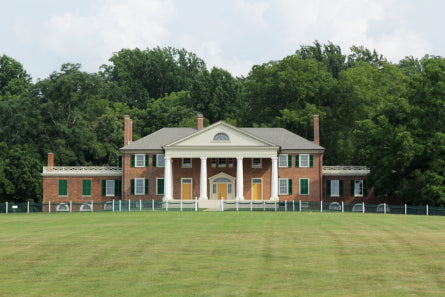








If there is one thing that Virginia has an abundance of, it’s history. And it’s not that unremarkable, something-happened-in-the-past-kind of history. It’s the bonafide, first-of-its-kind history. And we all know that's the good stuff. Early colonial settlements? Yep, we got the first. Battlefields? Which ones do you want to see: Revolutionary War or Civil War? Opposing forces literally decided the fate of the country within our state lines. Twice. Virginia’s history cred couldn’t get any tighter, right? Wrong. We haven't even talked Presidents. Virginia is home to more Presidents of The United States, eight, than any other state. For those reasons, and plenty of others, people travel significant distances to experience our version of history. But one of the great things about being based in Richmond is that the distances to some pretty unique historical sites are relatively minimal. On a sunny July afternoon, I decided to take advantage of our proximity to history and hike out to an area just north of Charlottesville, to visit the home of one of our founding fathers. James Madison’s Montpelier is roughly an hour-and-a-half drive from Richmond and only a half hour from Jefferson’s home at Monticello. Montpelier is found on 2,650 acres of rolling hills with a massive Georgian-style home as its centerpiece, and it is stunning. When I got there I met up with Terry Brock, Research Archaeologist at Montpelier. He invited me to come out to the field where he and his colleagues were conducting an onsite dig for the day. After the dig, we took a walk to the archaeology lab, where they process and catalog their findings. The lab is home to everything from Chinese export porcelain and broken 18th-century wine bottles to artifacts leftover from the Confederate Army encampment during the Civil War. Terry was on hand to provide more insight of how archaeology plays an important role at Montpelier.
What initially attracted you to working at Montpelier as a Research Archaeologist?
I had been following the work at Montpelier for a couple of years while I was working on my dissertation research. I was looking at an African American enslaved plantation and the transition from slavery-to-freedom for the people who lived and worked on that plantation. I had a lot of similar research interests as Dr. Matthew Reeves, who is the director of the archaeology program here. I had also been following this place for years, in particular, because of the public programing that we offer. We work with the public through our week long Expedition Programs, where we invite them to dig, excavate with us and learn about what archaeology is and why it’s important. These week long programs are great opportunities for the public to engage with their past, and for us to engage with them. Those are the two things that really attracted me to this place – I’m able to do great research and engage the public in a meaningful and unique way.
It seems that archaeology is a very important element of Montpelier. Do other historic homes throughout the state have that same level of care as far as their programing?
Both Monticello and Mount Vernon have incredibly active archaeology programs, as do other homes. They are both wonderful colleagues and we communicate with them regularly because we’re working on sites that are very similar. Not to mention, Thomas Jefferson and James Madison were close friends so that means our institutions like to work together as well. Through archaeology, we can learn about everybody – James and Dolly Madison, and the enslaved African Americans who lived and worked here. Archaeology helps give a full picture of who James Madison was, because James and Dolly can’t be James and Dolly if they don’t own people who cook, clean and work the fields. It’s important to tell the stories of people who didn’t have access to the written record, the slaves, and we do that through archaeology by discovering the tools that they used and the buildings that they lived in.
In the rank of influential American Presidents, where does James Madison place?
Madison is probably the least acknowledged of the founding fathers, but his role within the group was enormous. Jefferson gets a lot of the glory for a lot of things but he and Madison were good friends and they worked together on a lot of projects. After all, Madison was Jefferson’s Secretary of State when the Louisiana Purchase happened, he is regarded as the father of the Constitution, and was an influential president in his own right. There’s a lot to Madison but I think people just don’t know a lot about him. What we have at Montpelier is an opportunity for people to learn about a president, scholar, writer, husband, planter, and politician. Not to mention his wife, Dolly, who completely invented the position of the First Lady as a political figure. She’s a big deal because First Ladies are still doing a lot of the things that she started.
You mentioned the variety of public programs that are available here. Could you tell us more about them as well as how Montpelier is used today?
We have a lot of different things going on and we’d like to think that there’s a little something for everybody here. If you are interested in history and the presidents, there’s a lot for you to do here. There are daily house tours and special tours about slavery, women and the Constitution. If you are into archaeology and want an active experience, you can come to the Expedition Program. If you are into historic houses and interior design, we are engaged in maintaining the historic preservation and furnishing of the home. We also have the retirement community for the horses and host horse races on the track. Then there’s the Robert H. Smith Center for the Constitution where people can study what constitutions are, what democracy is, and Madison’s legacy overtime. There are all kinds of things happening here.
The Montpelier Foundation has an active blog and social media presence. How does this impact and influence your work?
We try to write on the blog as much as we can. The Archaeology Department also contributes to Facebook and Twitter regularly and we also have our own Google+ page, and myself, the staff, and our volunteers post on our own accounts using #DigMontpelier. I like to use social media as a means of taking the experiences that we’re having in the field and sharing them with the public. If I find something significant, I can take a picture of it, post it on the Internet and share it with our digital public. There are a lot of times when we’re out in the field, like in the woods, where visitors can’t just stop by. So how do we make that work that we’re doing out there accessible the public and invite them to be a part of those discovery moments? That’s the powerful part of archaeology. It’s a tangible history that you can hold in your hands and say, “I’m the first person in 200 years to touch this thing.” Although social media is digital, we always want people to be a part of those discovery moments.
It’s notable that you all invite others to join in on the process.
We’re active scholars and in academia, a journal article takes us years to get out. On the other hand, I can write a blog post and get that information out relatively quickly. In the context of a blog post, I can say, “this is what I think it is, but we have to do more research,” but at least it’s out there. I have colleagues who follow us that can provide feedback, so that’s going to broaden the knowledge of what we’re finding. This is starting to change the way we do scholarship and the way museums do engagement. It also mimics what we do through our Expedition Programs: we want the public to be engaged with our work by being a part of it.
So much history exists in Virginia. Where are some of your favorite places to explore?
I moved to Richmond last August, and what a cool historic city that could be even cooler and more historic. I’ve been pretty active with establishing a new organization, RVA Archaeology. The organization is an effort to make people in Richmond more aware of the archeological resources that exist in the city, which are plentiful. There’s definitely more opportunity for the city to embrace its historical and cultural heritage. We’ve been trying to work with folks to make them more aware. A city that is integrating archaeology into planning phases in an impactful way is Alexandria. I lived in Williamsburg for a while and that’s also a fun place to go back in time for a little bit.
A FEW NOTES ON JAMES MADISON
James Madison’s grandfather acquired Montpelier land in 1723. James Madison attended the College of New Jersey, known today as Princeton University, from 1763-1765. James Madison helped organize and participated in the Constitutional Convention of 1787, for which he prepared by reading 400 books on political theory in his library at Montpelier. Never missing a day, Madison took copious notes during the Convention, becoming its unofficial scribe, which were jointly edited later in life by James and his wife, Dolley. They were published posthumously and today reside at the Library of Congress. James Madison is known as the Father of the Constitution. While he did not personally write every part of the Constitution, he was a key player in all discussions and forcefully argued for many items that would eventually make it into the final draft. Madison was the last founding father to die at the age of eighty-five on June 28, 1836.Keep up with the Archaeology Department through the Montpelier Foundation’s Facebook, Twitter, Terry’s Twitter and through following #DigMontpelier. Visit the Montpelier Foundation’s website for more information about James Madison, special events, public programs and planning a trip to Montpelier. Photographs appear courtesy of The Montpelier Foundation











